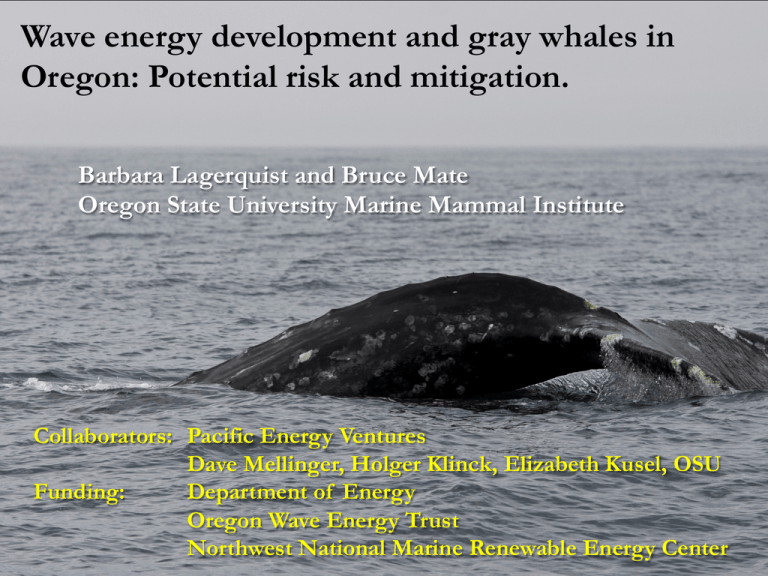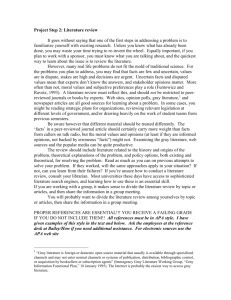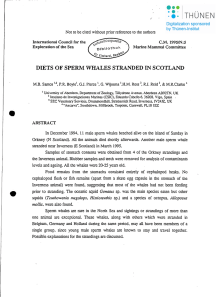Wave energy development and gray whales in
advertisement

Wave energy development and gray whales in Oregon: Potential risk and mitigation. Barbara Lagerquist and Bruce Mate Oregon State University Marine Mammal Institute Collaborators: Pacific Energy Ventures Dave Mellinger, Holger Klinck, Elizabeth Kusel, OSU Funding: Department of Energy Oregon Wave Energy Trust Northwest National Marine Renewable Energy Center Eastern North Pacific gray whale Minimum Popula,on Es,mate -­‐ 18,017 (NOAA 2010) Wave energy development and gray whales 2007-2008 OSUMMI shore-based observational study – funded by Oregon Wave Energy Trust (Joel Ortega-Ortiz and Bruce Mate) Objective: • Obtain accurate, up to date information on the distribution of gray whales migrating along the central OR coast Wave energy development and gray whales Loca,ons from scan surveys Yaquina Head Southbound Dec – Feb 25 Distance = 6.6 + 2.53 km Median Depth = 54.3 m n = 139 Wave energy development and gray whales Northbound Phase A Feb 26 – Apr 9 Northbound Phase B Apr 10 – May 27 Distance = 5.1 + 2.13 km Median Depth = 46.9 m n = 230 Distance = 4.1 + 2.62 km Median Depth = 40.5 m n = 91 Theodolite-­‐tracked whale paths Yaquina Head Southbound Dec – Feb 25 Mean = 6.7 + 1.38 km/h n = 37 Wave energy development and gray whales Northbound Phase A Feb 26 – Apr 9 Mean = 6.0 + 1.09 km/h n = 47 Northbound Phase B Apr 10 – May 27 Mean = 5.4 + 1.53 km/h n = 26 Occurrence of gray whales within the Oregon Territorial Sea (OTS) Migration phase Time period Locations Inside OTS Outside OTS Southbound Dec - Feb 25 139 41.0% 59.0% Northbound Phase A Feb 26 - Apr 9 230 67.4% 32.6% 91 78.0% 22.0% 460 61.5% 38.5% Northbound Phase B Apr 10 - May 29 Total Wave energy development and gray whales Ocean Power Technologies (OPT) PowerBuoy (FERC 2007) Wave energy development and gray whales Wave energy development and gray whales Acoustic Deterrent Study -­‐ OSUMMI and Pacific Energy Ventures Objective Deflect the movement of gray whales by 500 m with the use of a low-power sound source. Goal A successful device may be useful as a mitigation tool to keep gray whales away from wave energy facilities should they prove a collision or entanglement risk Wave energy development and gray whales Acoustic Deterrent Study - Approach • Moor acoustic device off Yaquina Head, in part of gray whale migratory path (Jan-Apr 2012). • Transmit sound during experimental period each day during daylight hours • Conduct concurrent shore-based observations of gray whales using theodolite to accurately track position, trajectory, and speed • Compare results between experimental and control (no sound) periods, as well as 2008 data. Wave energy development and gray whales Intensity: an example sound: Scripps Inst. Oceanogr. Gray whale sounds: 142-185 dB re 1 µPa @ 1 m à In air: 80.5 - 123.5 dB re 20 µPa @ 1 m In comparison: - Lawn mower: ~90 dB re 20 µPa @ 1 m - Car horn: ~110 dB re 20 µPa @ 1 m The logarithmic nature of the dB scale means that each 10 dB increase in intensity is a tenfold increase in acoustic power. A 20-dB increase is then a 100-fold increase in power, and a 30-dB increase is a 1000-fold increase in power. A ten-fold increase in acoustic power does not mean, however, that the sound is perceived as being ten times louder. Humans perceive a 10 dB increase in sound intensity as only a doubling of sound loudness. Marine Mammals and Sound Dave Mellinger What we know Malme et al.1: 50% of migra,ng gray whales showed behavioral responses to “industrial” sounds received louder than 120 dB re 1 µPa @ 1 m. Tyack and Clark2: Migra,ng gray whales responded to a low frequency ac,ve military sonar with a source level of 185 dB re 1 µPa @ 1 m. Tyack and Clark (1998) C. I., P. R. Miles, C. W. Clark, P. L. Tyack, and J. E. Bird. 1983. Inves,ga,ons on the poten,al effects of underwater noise from petroleum industry ac,vi,es on Malme, 1 migra,ng gray whale behavior. BBN Rep. 5366. Rep. From Bolt Beranek and Newman, Inc., Cambridge, MA, for U.S. Minerals Manage. Serv., Anchorage, AK. Var. pag. NTIS PB86-­‐174174. 2Tyack, P. L., and C. W. Clark. 1998. Playback of low frequency sound to gray whales migra,ng past the Central California coast – January, 1998. Quick Look report LFA phase II playbacks to migra,ng gray whales. Unpublished Report. Available from the Na,onal Marine Mammal Laboratory. Wave energy development and gray whales Sound propagation modeling (Kusel et al. 2009) December Wave energy development and gray whales March Deterrent Specifications Signal: FM sweeps, 1-3 kHz, 1 s duration Source level: 170 dB re 1 µPa @ 1 m Repetition rate: 3 sweeps per minute (when on) Duty cycle: on for 6 hours per day, off for 18 Sound emission: total of 18 minutes per day Ramp-up: start at 120 dB and increase by 5 dB every minute Wave energy development and gray whales Deterrent Equipment Wave energy development and gray whales Data Collection Number of days of observa,on – 51 Number of scans – 136 Number of scan loca,ons – 144 Number of focal follows -­‐ 57 Wave energy development and gray whales Sponsors and Staff Oregon Wave Energy Trust Oregon State University Marine Mammal Ins,tute Endowment Department of Energy Pacific Energy Ventures Northwest Na,onal Marine Renewable Energy Center Bureau of Land Management – Yaquina Head Outstanding Natural Area Wave energy development and gray whales Shore-­‐based observa,on teams Holland Banks, Dalin D’Alessandro, Julie House Ladd Irvine, Craig Hayslip, Tomas Follej Erin Kunisch, Alan Low, John McClung






